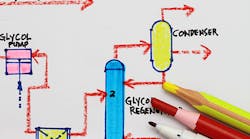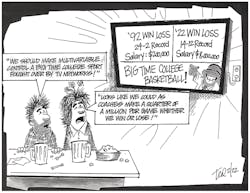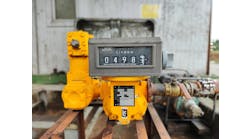This Control Talk column appeared in the March 2022 print edition of Control. To read more Control Talk columns click here or read the Control Talk blog here.
Greg: If you look at a process flow diagram (PFD), you see there are flows given for each process and hopefully each utility stream. The goal of a control system is to maintain these ratios for the given set of operating conditions and correct them as necessary to account for unknowns and disturbances particularly in terms of concentrations. When units are started up (e.g., distillation columns), the units may be brought to operating conditions based on ratio control before being switched to temperature or composition control.
A change in feed to one unit operation has a widespread ripple effect on downstream unit operations. Ratio control can keep all the units in balance with the total production requirement without waiting on feedback controllers to see and correct an error from the unbalances. Not only does an appreciable error have to develop for feedback correction, but the settling time (time for the process variable to stay close to setpoint) can be quite long—especially if there is any interaction between the loops. For day-to-night optimization, the production unit may be in a constant state of disruption.
If feed flows can be moved in concert quickly throughout the process, production rates can match changes in market demands without requiring as much product in storage tanks. Reducing product inventory is important for reducing bottom-line costs. Changes in product grade also require changes in existing feed rates and addition and deletion of feeds. Transition time and off-spec product can be minimized by using ratio control throughout the units.
To help us realize the benefits of ratio control we get the inside perspective of Michel Ruel, ISA Fellow and co-chair of the ISA 5.9 Technical Report on PID Algorithms and Performance, and interviewee in the recent, insightful Control Talk columns “Want to be a hero” and “Keys to optimization project success.”
Michel, how do we decide whether to use ratio control or flow-feedforward?
Michel: Ratio control is preferred over flow-feedforward control, so the flow controller can correct for valve nonlinearities and pressure disturbances, and the operators and process engineers can be more involved in seeing and understanding how control system is working in concert with the PFDs. The ratios are typically mass flow ratios. Using Coriolis mass flowmeters provides correction for density and potentially composition changes in the streams, besides offering great accuracy and rangeability. If volumetric flowmeters are used, they may need to be corrected for density. This is commonly done for gas flow measurements by temperature and pressure compensation assuming a constant composition.
However, in some applications, flow controller response is erratic or too slow, and feedforward control is consequently used instead of ratio control to directly manipulate a control valve or variable speed drive based on feedforward and an installed flow characteristic. This is typically the case for steam-header systems, where the installed flow characteristic of the upper header letdown valve is used as a flow-feedforward for the lower header along with the net result of users and suppliers for the lower header. The half decoupling and preemptive correction for changes in supply and demand has been shown to greatly improve the control of headers, eliminating unnecessary venting.
Greg: What are some examples?
Michel: There are many examples of unit operations where flow, speed or power is ratioed:
- Blend composition control – additive/feed (flow/flow) ratio
- Column temperature control – distillate/feed, reflux/distillate, reflux/feed, steam/feed, and bottoms/feed (flow/flow) ratio
- Combustion temperature control – air/fuel (flow/flow) ratio
- Drum level control – feedwater/steam (flow/flow) ratio
- Extruder quality control – extruder/mixer (power/power) ratio
- Heat exchanger temperature control – coolant/feed (flow/flow) ratio
- Neutralizer pH control – reagent/feed (flow/flow) ratio
- Reactor reaction rate control – catalyst/reactant (speed/flow) ratio
- Reactor composition control – reactant/reactant (flow/flow) ratio
- Sheet, web and film line machine direction (MD) gage control – roller/pump (speed/speed) ratio
- Slaker conductivity control – lime/liquor (speed/flow) ratio
- Spin-line fiber diameter gage control – winder/pump (speed/speed) ratio
- Header pressure control – letdown/user (flow/flow) ratio
- Density control – slurry/water, pulp/water (flow/flow) ratio
- Formation on a paper machine – fibers/machine (speed/speed) ratio, where pressure in head box converted to kinetic energy provides inferential measurement of speed of fibers
Greg: What is the architecture for flow ratio control?
Michel: The main flow is the wild flow (not controlled) or leader flow (set by production rate); secondary and tertiary flows need to follow at a certain ratio to the wild or leader flow. If the flows go to plug-flow volume, a process feedback controller corrects the ratio, which is equivalent to a feedforward multiplier. However, if the volume has significant back mixing, the process time constant being inversely proportional to flow cancels out the process gain nonlinearity. In this case, the correction of the ratio-control ratio creates a residual nonlinearity that adversely affects PID tuning, and it is preferable to have the PID correct the ratio-control bias, which is equivalent to a feedforward summer.
Greg: The correction of the bias is also particularly good at dealing with the more common and larger zero error or offset instead of span error in flow measurements. Adaption of the ratio can be done automatically by something like a valve position controller that's a mostly “integral only” to slowly correct the ratio and minimize the process controller feedback correction. Procedure automation and state-based control can also proactively improve the ratio for startup and transitions besides abnormal conditions.
What are some common problems and fixes?
Michel: The PID controller uses feedback error to reduce the feedforward error, hence we have transitory responses. And, even if the process variable (PV) will return to setpoint (SP), errors are unavoidable. During transient responses, actual ratio will vary. For example, if the leader flow changes brutally, other flows will seriously fall behind. If possible, the leader flow should change slowly (usually larger valves move more slowly) and use an architecture where all streams are controlled with a ratio. With proper tuning and PID structure, such as two degrees of freedom, each loop may have close to the same setpoint response time.
Many flowmeters have poor rangeability and large sensor errors at low flow. For example, a flowmeter may not realistically be able to measure below a certain flow (e.g., 15% for a vortex meter and 25% for an orifice flowmeter). Suggested solutions are first to use a magnetic flowmeter or, even better, a Coriolis meter that's properly sized with an error in percent of reading that's relatively constant and small. If this isn't feasible, consider more than one flowmeter (e.g., 0-30% of flow using differential-pressure (DP) transmitter 1, and 30-100% of flow using DP transmitter 2, possibly with different technologies). Also, at low flow, a soft sensor may be added based on pressure and valve opening, taking into account the installed flow characteristic.
Greg: For much more detail, see the ISA Mentor Program WebEx presentation “Feedforward and Ratio Control” and the follow-up “Feedforward Control Q&A Addendum.”
10. Maximize robustness of temperature control by ratio control per PFD energy balance
9. Maximize robustness of composition control by ratio control per PFD material balance
8. Maximize robustness of pH control by ratio control per PFD material and charge balance
7. Minimize by ratio control the stress dealing with problems from startups, transitions, and analyzers
6. Realize gain of raise in ratio of $ benefits from process control improvement to $ cost of ratio control
5. Maintain your weight by ratioing the calories eaten to calories burned
4. Improve your children’s performance by ratioing your praise to their ethics and efforts
3. Wish the truth in political promises was a 1:1 ratio of realizable reality
2. Hope the win-loss record of your favorite team is ratioed to the coach’s salary
1. Recognize the ratio of the expression of appreciation of spouse to your free time to watch sports







